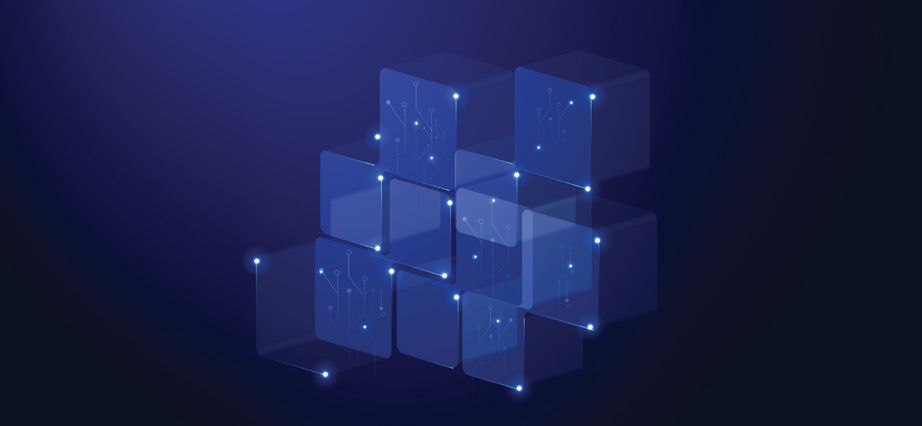
AI For The Arab World
The rise of Arabic-specific AI models in Saudi Arabia is redefining industries with their accessibility and efficiency While generative artificial

Understanding blockchain (and the revolutionary potential it holds).
Over the last decade, revolutionary new technology has compelled a communal rethinking of the internet’s possibilities. It’s not artificial intelligence (AI), social media, or the internet of things; it’s a technology known as blockchain, which some have dubbed “the new internet.” It is considered to be a technology that allows engineers to develop decentralized and distributed applications (DApps) in a trustless environment.
We can define blockchain as a decentralized network of participants collaborating to build and update a common database (often called a ledger) in a secure and trustless manner. The storage of this database is also decentralized. It is not stored in a central location, but a copy of it is stored in each participant’s repository. The word blockchain derives from the structure of this common database. The database is laid out in a string of connected blocks, a chain of blocks that starts with block #1 and gets updated by adding block#2, then block#3, and so on to block#3+, and onwards indefinitely.
From the above definition, we learn that there are two aspects to the blockchain, the first of which is the decentralized nature of the network of collaborators. The second is the structure of the database (chain of blocks). Lately, the definition of blockchain has been watered down to only include the second aspect. The reason is that use cases have emerged where only the innovative data structure is required, and the decentralized network is not.
It is also worth to note that new technologies, inspired by blockchain, have proposed a completely new structure for storing this common ledger. Examples of such technologies are Hashgraph, IOTA, Tangle, and R3 Corda. These technologies along with blockchain are now grouped under the term decentralized ledger technologies (DLTs).
HOW BLOCKCHAIN WORKS
At its core, blockchain is a database. However, it is not just a database that stores random information. It is a ledger that stores a specific kind of information, and by storing and maintaining this information, the blockchain serves a specific purpose. Let’s take an example, and what is better than the first blockchain application, Bitcoin.
The purpose of the Bitcoin blockchain is to serve as a peer-to-peer digital currency system. And so, the aim of the blockchain in this case is to record all transactions made by participants since the dawn of Bitcoin. Every transfer of Bitcoins ever made since 2009 is recorded in the Bitcoin blockchain. It is a large chunk of data- indeed, the Bitcoin blockchain’s size is now approximately over 300 gigabytes. You can publicly browse through all these transactions using any of the blockchain explorer websites available.
Nevertheless, by maintaining this ledger of transactions, the system can easily track each participant’s balance at any given time by simply knowing the history of all incoming transfers and all outgoing transfers. Add all the incoming, subtract all the outgoing, and you will get the balance. The blockchain in this case doesn’t need to store the balances. All it needs to store -to serve its purposeis the complete history of all transactions.
The structure of the blockchain can be imagined as a single string of blocks. Bitcoin’s blockchain, as of this date, has over 700,000 blocks. Each block is also framed with extra data that are called cryptographic digital signatures. The reason why data in the blockchain is stored in this manner is that it is intended to be immutable. Any data stored in the blocks are locked in forever. No one can tamper with the data, because of the cryptographic signature scheme. If one single bit of data is changed, the digital signature of that block will change, immediately raising a red flag. And because the digital signature of that block is stored in the next block, the next block will also have its signature changed, triggering a chain reaction down the blockchain that essentially spoils the whole chain, and makes it visibly corrupt for everyone to see.
In general, the Bitcoin network comprises two kinds of participants: users and miners. The users own digital wallets and send and receive amounts of Bitcoin. The users don’t need to store the entire blockchain on their devices. All they need is digital wallet software (or a smartphone app) and an internet connection. When a user wants to send Bitcoins to another user, the app doesn’t send a digital file containing Bitcoin, as some may imagine. What happens is that the app only sends a transaction request to the network. So, users are essentially asking the network to log their transactions onto the blockchain.
A miner, on the other end, listens to transaction requests on the network, collects them, places them inside a block, performs tedious cryptographic work on it, and finally, when the block is ready, they attach this new block to the current version of the blockchain. And by that, the miner has updated the blockchain. Other miners will update their copies of the blockchain accordingly, after verifying the work. So, miners are essentially the accountants of the network. They update, verify, and maintain the blockchain and its integrity. They are incentivized to do so because the Bitcoin protocol offers newly minted Bitcoins to the miner that manages to add a new block to the chain. Lastly, unlike users, miners do have to store the entire Bitcoin blockchain at their repositories. They also need great computing power to run through the numbers quickly enough, and find that specific number that will satisfy some arbitrary cryptographic rule set.
The major takeaway here is that the network aims to record transactions on the blockchain and have a unanimous consensus over the current version of the blockchain. That, in a nutshell, is how Bitcoin works.
FEATURES OF BLOCKCHAIN TECHNOLOGY
TOKENIZATION When the computer age started to boom at the beginning of the 21st century, one main highlight was the explosion of information. Everything digital was easily shared across the network. People shared photos, videos, books, and music seamlessly. When things are digitized, they can easily be copied, pasted, and shared. And so, when it came to creating a digital currency (or a digital token that represents anything), computer programmers were facing an infamous issue called “the double spend problem.”
In short, if a digital token exists, what prevents anyone from copying that token and spending it elsewhere? Hence, double spend. Back then, the only tokenization possible was via a central entity that mints these tokens on its digital platform, and everyone had to trust it. Other than that, trustless tokenization was just a dream. But now, with blockchain technology, that dream has been realized. The double spend problem was solved without the need for a central authority.
When thinking about it, cash or gold don’t have this double spending issue, given their tangible nature. Once a paper riyal is given out to a merchant, it can’t be spent again elsewhere. The problem only arises in the digital world. So, when blockchain solved the problem, it essentially introduced tangibility to the digital world. And that has since been proven to be an extremely powerful tool.
The idea of tokenization can go much beyond cryptocurrencies. Basically, any asset that the market values can be tokenized. Many efforts across the globe have already started working on tokenizing real estate, financial assets, stocks, equity, vehicles, and more. And by having these assets as tokens on the blockchain, people can easily trade them, leverage them, and store them. Implementing such a transformation will further enhance the digitization efforts every government nowadays strives for.
DATA SHARING AND COLLABORATION In case we need a data-sharing platform between several entities, blockchain offers a decentralized solution to build this platform. Note here that blockchains don’t always have to be public. Blockchains can be tailored to work privately. Meaning, that only specified whitelisted participants are allowed to join. And for that matter, private blockchains can exist on top of public ones. This scenario is called a hybrid solution. The advantage of this scheme over conventional data center solutions is that a decentralized network will have virtually zero downtime. Also, a decentralized network has no single point of failure, unlike conventional data centers.
DATA SECURITY Protecting data involves several different practices: preventing access to protected data, encrypting the data (so that if any penetration happens, the intruder will not be able to read the data), and protecting the data from any tampering.
Now, blockchain has enhanced security measures in practice. Before blockchain, cryptographic timestamping methods were available, where documents that were timestamped can be verified that they were created before a certain date and that the copy does match the original without any change whatsoever. However, those methods only handled a static amount of data. Blockchain, on the other hand, continuously timestamps an ever-growing amount of data, let alone the timestamping that occurs for a database with multiple authors all collaborating simultaneously.
When thinking of applications for blockchain data security, we don’t need to be limited to decentralized networks. This feature of blockchain can be used in a centralized fashion. If one single institution maintains an ever-growing database, and the nature of the database is intended to be immutable, then blockchain would be a great fit for them.
SMART CONTRACTS These are pieces of code embedded in the blockchain. They bring the power of a programming language to blockchain developers to tinker with. Smart contracts are usually used when transactions need to rely on certain conditions before they can be executed. Examples of such conditions include the occurrence of a transaction, the passage of time, the approval of a party, the voting result of multiple parties, and external data like weather or assets’ prices. Based on such conditions, several actions can be executed. Examples of such outputs include performing transfers, calculating a certain value (reward, penalty), updating data, or notifying a party.
Smart contracts have become the bedrock of a new economy. New markets are now created with smart contracts allowing people to transact and commit seamlessly across state borders. They opened new possibilities in the entertainment industry. For instance, non-fungible tokens (NFTs) are smart contracts. Since the introduction of smart contracts, the world has been steering towards trustless automation of processes. Examples of currently running successful smart contracts:
DIGITAL ID AND WEB3 Digital ID is a set of digital attributes and credentials that identify a person or an entity to be used in the digital world. Just like when people navigate the real world, they identify themselves with an ID card or a fingerprint, similarly when they navigate the digital world, they can identify themselves using a digital ID in order to interact with public and private entities.
Digital ID is not necessarily a product of blockchain innovation. However, it became easier to facilitate using blockchain’s digital wallets. Currently, in the crypto space, anonymous users are interacting with many services in the decentralized finance world using only their digital wallets as their identifiers. In this case, they are considered unique but anonymous. Governments can utilize this technology to issue digital IDs for their citizens, allowing them to interact with public institutions and private institutions like banks online seamlessly and securely.
Web3 is the concept of using digital wallets to interact with websites online. It envisions an internet that removes the login process requiring usernames and passwords and replaces it with seamless navigation using digital IDs. Couple that with the ability to transfer value between these digital wallets to get a more complete idea of how Web3 will operate.
FORESIGHT
The blockchain for Bitcoin has been around for well over ten years, yet it is merely the first generation of DLTs. Numerous methods and algorithms that are more technologically advanced than blockchain have been created throughout that decade. The DLT industry has been promoting the use of even more cutting-edge technology. Many diverse projects seek to be more than simply a cryptocurrency and are built on advanced concepts. By exploiting the decentralized characteristics of DLTs, those projects seek to benefit various industries.
According to the Technology Foresight Center at the Ministry of Communications and Information Technology, the most central problem of a DLT is what has been dubbed “the blockchain trilemma”:
> Decentralization ensures that the DLT does not depend on a central point of control.
> Scalability refers to the ability to handle an increasing number of transactions.
> Security is the ability of the network to defend itself against attacks, bugs, and technical issues.
Different projects attempt to solve this trilemma using different approaches, while keeping true to the goals of the project. Each project has to balance a trade-off between those three factors without compromising any of them. Looking ahead to the future, the world is moving forward at an enormous pace toward different applications of DLTs. Most of these projects aim globally, but some aim at local or domestic levels.
Lastly, to recap what we have demonstrated on some of the blockchain use cases, like the smart contracts (DEX, DeFi, and DAO) and Web3: this will open an enormous amount of opportunities for some sectors of government and private. Smart contracts, in general, will allow more flexibility in performing functions and transactions from finance to properties and assets. With the presence of Web3, every individual can have the right to utilize what services he/she would like, especially in healthcare, governmental documents, financial transactions, and more. And from our vantage point at Saudi Arabia’s Ministry of Communications and Information Technology, we can conclude that this is one of the most important directions to follow in the next couple of years.
Discover the most outstanding articles.اكتشف أبرز المقالات.

Harnessing the power of digital twins to reimagine cities across the KSA and beyond. According to PwC’s 2022 report,

How Riyadh-based The Garage is contributing to a flourishing startup culture in Saudi Arabia In the heart of Riyadh, nestled

Saudi astronauts Rayyanah Barnawi and Ali Alqarni make history in giant leap for the kingdom. From earthbound dreamers to cosmic